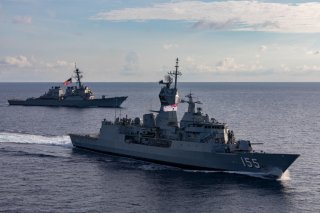The United States and Australia Are Stepping up Naval Cooperation
The meeting revolved around how to get the most out of the American and Australian relationship from a naval perspective.
The United States and Australia held a high-level dialogue on how to cooperate for better interoperability in the Indo-Pacific.
A recent U.S. Navy press release explained that the “United States Deputy Chief of Naval Operations for Operations, Plans and Strategy, Vice Adm. Bill Merz and his Australian counterpart, Rear Admiral Chris Smith, Royal Australian Navy, Deputy Chief of Navy, co-hosted a strategic dialogue via video teleconference Feb. 16.”
The meeting revolved around how to get the most out of the American and Australian relationship from a naval perspective.
"Our capacity expands when we sail in company and operate with like-minded navies across the globe,” said Merz. “A key ally like Australia is critical to enhancing our joint capabilities and interoperability in the Indo-Pacific region. That includes traditional maritime security and stability, as well as emerging areas of importance like cyber and artificial intelligence.”
The Navy press release explained in a bit more detail that “broadly speaking, the framework aims to strengthen existing cooperation, address mutually strategic issues, and promote collaborative development and utilization of science and technology between both navies.”
The United States and Australia made a splash late last year when they announced, along with the United Kingdom, that the three countries were banding together on naval technology. In essence, the United States and the United Kingdom offered to hand the crown jewels of their naval technology to Australia: nuclear-powered submarines.
The move came as tensions in the Indo-Pacific are ratcheting up. China is on a shipbuilding spree, and the latest estimates place their ships at around 355 in number. And while the United States is slowly building up its naval forces, their pace does not match the Chinese—a strong incentive to join forces with the Australians.
Down Under
The Australian Navy is a newcomer to nuclear technology. Despite holding an estimated 33 percent of the world’s uranium deposits, the continent has never hosted a nuclear power station, largely thanks to abundant coal reserves.
Australia’s submarine fleet is a far cry from powerful American or British vessels, though the Royal Australian Navy may inherit, or at least train on, older American or British designs that are approaching retirement.
The U.S. has long been a vital partner in ensuring a free and open region in which we and our neighbors can prosper,” Rear Admiral Chris Smith said.
Regarding the joint naval dialogue, the Royal Australian Navy said the following: “These talks, although not face to face, provide an opportunity to build on that relationship, which forms the basis on which we can work together to build a stronger and more stable region.”
Caleb Larson is a multimedia journalist and defense writer with the National Interest. A graduate of UCLA, he also holds a Master of Public Policy and lives in Berlin. He covers the intersection of conflict, security, and technology, focusing on American foreign policy, European security, and German society for both print and radio. Follow him on Twitter @calebmlarson.
Image: Flickr/U.S. Navy.

